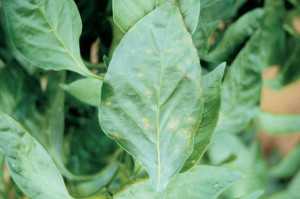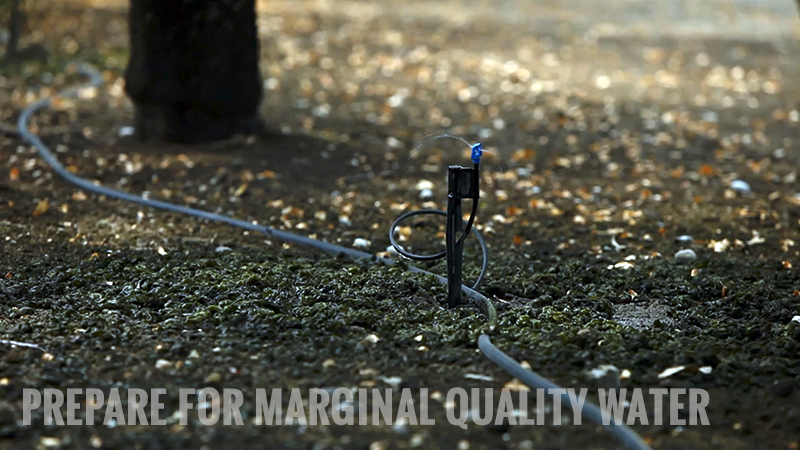Pepper Growers Must Be Proactive With Bacterial Spot

Leaves with bacterial spot symptoms have brown lesions surrounded by yellow halos.
Photo credit: David Langston, University of Georgia
Bacterial spot (Xanthomonas euvesicatoria) is a nasty foliar disease that can devastate pepper yields if allowed to run rampant, especially when warm, wet weather is present. Growers who are quick to go on the offensive with the use of resistant varieties, pre-emptive fungicide treatments, and good cultural controls will have the most success with keeping this destructive disease in check.
Knowing the conditions that favor bacterial spot can help prevent its spread from plant to plant. Excessive rainfall, high humidity, and warm weather are especially conducive to the disease. Splashing from rain or overhead irrigation can quickly disperse the disease throughout a field or greenhouse.
Infected transplants and seeds can harbor inoculum, as well as crop debris and weeds from the Solanaceae family. Human hands and equipment can transfer bacteria from diseased plants mechanically, particularly when they are wet. Early recognition of bacterial spot’s symptoms can also help avoid the spread of the disease.
Defoliation from bacterial spot often shows up on the bottom of the plant first and works its way upward. Water-soaked areas appear on leaves, foliage, stems, and fruit. They quickly turn to brown lesions surrounded by a yellow halo. Affected leaves turn yellow and drop.
Have A Plan For Control
According to David Langston, Extension plant pathologist at the University of Georgia, control measures should be in place long before peppers show visible signs of bacterial spot. Once symptoms show up, crop loss is inevitable.
Effective control of bacterial spot takes an integrated, full-season management approach that combines preventive measures with cultural controls to ensure that peppers start healthy and stay healthy.
“The use of resistant varieties is the first line of defense for bacterial spot on peppers and one of the easiest ways to control the disease,” says Langston. Resistant pepper varieties
are race-specific, so it is a good practice for growers to choose varieties that have known resistance to local bacteria strains. Langston notes that growers should be aware that there are no resistant varieties for specialty peppers. Fungicide treatments are often the best way to manage bacterial spot in these circumstances.
“A preventative spraying program should be in place from the start for any pepper program,” Langston says. “The key is to spray early and spray often.” He recommends copper and Mancozeb sprays for control of bacterial leaf spot. Actigard (Syngenta Crop Protection) and Quintec (Dow AgroSciences) are also good preventives.
A three- to five-day schedule is adequate for fungicide treatments in most cases. However, the frequency of treatments may need to increase when conditions are present that favor bacterial spot.
Keep Things Clean
In addition to using resistant varieties, start with certified, clean seeds and disease-free transplants. Transplants should be isolated prior to planting until they can be examined for disease symptoms. Practice good sanitation by washing hands after handling plants and disinfecting equipment. Avoid walking or driving through wet fields until they have had a chance to dry out.
Another wise management practice is to eliminate excess moisture whenever possible with good drainage. Switching from overhead irrigation to drip irrigation keeps water accessible to the roots while keeping the foliage dry. It also lessens the chance of dispersion through splashing.
Other management practices include weed control and crop rotation.










